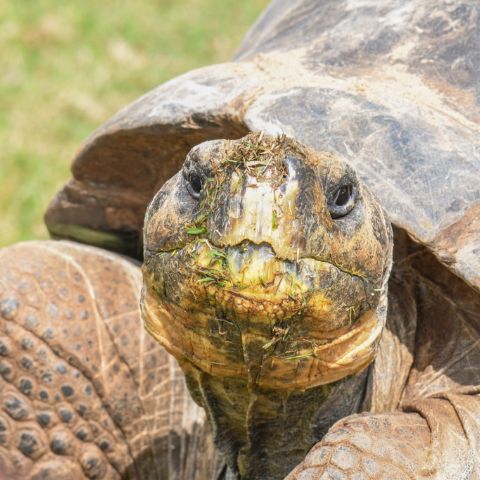Veterinary team pharmacokinetic study to improve pain management for a Galapagos tortoise
Introduction: Arthritis in tortoises is a common ailment as they age, and managing the pain is a critical component of clinical veterinary care. Treating animals with proper medication has been challenging due to a lack of knowledge on how different species metabolize varying drugs.
Case study: To alleviate the arthritic discomfort in one of the Zoo’s female Galapagos tortoises named Ms.B, the veterinary team started treating her with tramadol, a medication that is typically used in humans but rarely in tortoises. As there were no dosages reported in tortoises, a tramadol dose was assumed from aquatic turtles. The team soon found out the differences in how turtles and tortoises metabolize the drug; Ms. B became very sleepy and sedate after administration. The team lowered the dose to optimize Ms. B’s comfort.
Solution: To establish the ideal tramadol dose for Galapagos tortoises, a pharmacokinetic study was performed, investigating how the medication is metabolized in the tortoises. Three adult and eight juvenile tortoises received oral doses of tramadol, and blood was drawn after administration to determine how long the last remnants of the medication left their systems. After three weeks, another study was performed with a different dose. The concentration of the drug levels in the blood collected was assessed in a pharmacology laboratory to determine the appropriate dose and frequency of administration.
Results: The pharmacokinetic study found the correct dose of tramadol for Galapagos tortoises and the frequency at which it should be given, allowing Ms. B to receive optimal pain management and raise the overall life quality of the animal. The study hopes to aid in treating giant tortoises and other related species in the wider zoo community.
Read the Source Here
Animal care is a crucial aspect of zoos and aquariums that diligently work to preserve and propagate endangered species. Veterinary care is one of the key factors that ensure the health and well-being of captive animals. In recent years, significant advancements have been made in veterinary care, providing better treatment options for animals in captivity.
The Story of Ms. B.:
Ms. B. is a Galapagos tortoise and a resident of the Reid Park Zoo in Tucson, Arizona. Galapagos tortoises are listed as “vulnerable” by the International Union for Conservation of Nature (IUCN). They are one of the longest-lived animals on the planet, and it is not uncommon for them to live more than 100 years. Ms. B. has been living at the zoo since 1979 when she arrived from the San Diego Zoo.
From Initial Observation to Diagnosis:
In 2021, keepers noticed that Ms. B’s shell was starting to look different. They brought in Dr. Jessye Wojtusik, a board-certified veterinary radiologist from the Veterinary Specialty Center of Tucson, who used CT imaging to identify an unusual soft tissue growth on the underside of Ms. B’s shell. From the scans, it was apparent that the growth was likely attached to the outer surface of her shell. After her initial scans, Dr. Wojtusik suggested a biopsy to confirm the findings.
Advanced Diagnosis through Biopsy:
Dr. Alexis Moreno, a veterinary pathologist at LSU, led the biopsy of the soft tissue growth. The procedure was successfully conducted with Ms. B. under anesthesia. The biopsy revealed that the growth was a fibropapilloma, a benign tumor caused by a virus commonly found on turtles and tortoises. Biopsies in animals of this size are challenging and require the use of specialized equipment and expertise. In the past, these tumors were untreatable, eventually leading to death.
Advanced Treatment using Laser Therapy:
After confirming the diagnosis, the veterinary team decided to treat Ms. B’s fibropapilloma using an innovative laser surgery technique. Dr. Matt H. Barton, a board-certified veterinary surgeon, used a carbon dioxide laser to remove the soft tissue growth in a virtually bloodless procedure, essentially curing Ms. B. of the disease. This treatment is a significant advancement in veterinary care, as it eliminates the need for complex surgical procedures that require a high level of anesthesia, which can pose significant risks.
The Aftermath:
After the laser surgery, Ms. B. received round-the-clock care and attention from specialists at the zoo’s hospital. She is now recovering well and is showing no signs of complications. The use of advanced technology and expertise in veterinary care saved Ms. B’s life and illustrate the benefits of modern veterinary care to save endangered animals, like Galapagos tortoises.
Conclusion:
In conclusion, this case highlights the importance of veterinary care and advancement in treatment options for captive animals. The technology and expertise applied in Ms. B’s treatment have been instrumental in her recovery from a condition, which would have been untreatable without invasive surgery. With continued improvements in veterinary care, zoos, and aquariums worldwide can ensure that the animals under their care receive the utmost care, leading to successful conservation and propagation programs.

